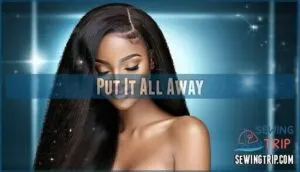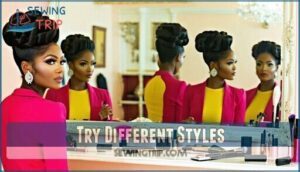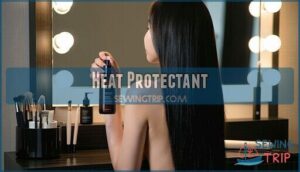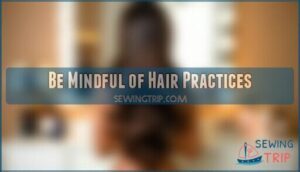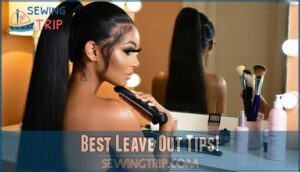This site is supported by our readers. We may earn a commission, at no cost to you, if you purchase through links.
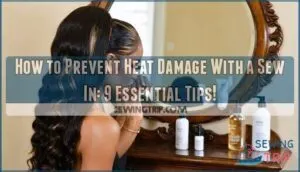 Learning how to prevent heat damage with a sew in starts with smart leave-out management. Keep your leave-out minimal – less hair means less potential damage.
Learning how to prevent heat damage with a sew in starts with smart leave-out management. Keep your leave-out minimal – less hair means less potential damage.
Always shampoo, condition, and moisturize before styling, then seal with oil. Twist or braid your leave-out when possible instead of constantly flat-ironing.
When you do use heat, apply a quality heat protectant and lower those temperature settings. Your edges are delicate, so treat them like fine silk.
Consider closures or frontals to eliminate leave-out entirely. Switch up your styling routine with protective curly looks or creative parts.
Remember, healthy hair is happy hair – and there’s so much more to keeping your sew-in gorgeous, with a focus on prevent heat damage.
Table Of Contents
Key Takeaways
- Keep your leave-out minimal – You’ll reduce heat damage risks by up to 70% when you expose less hair to styling tools, so only leave out what’s necessary to blend with your sew-in.
- Skip the heat when possible – You can create gorgeous styles using twist-outs, braid-outs, or protective braids instead of constantly reaching for flat irons and curling wands that damage your hair.
- Always use heat protectant and lower temps – When you must use heat, apply a quality heat protectant first and keep your tools under 350°F to minimize damage while still achieving your desired look.
- Consider closures or frontals – You’ll eliminate leave-out styling completely with these options, giving your natural hair maximum protection while still maintaining a flawless appearance.
Top 5 Leave Out Tips!
Your leave-out hair takes the biggest beating from heat styling, so mastering these five tips will keep it healthy and gorgeous.
Smart leave-out care means your sew-in looks fresh longer while your natural hair stays protected underneath.
Keep It Minimal
Since less is more with leave-out hair, keep it minimal to slash heat damage risks by up to 70%.
Think of your leave-out as precious real estate – you only need enough to blend seamlessly with your sew-in.
Your leave-out hair is precious real estate – protect every strand like it’s worth its weight in gold.
Too much exposed hair means more styling temptation and potential damage. When you’re feeling fancy, reach for styling alternatives like cute headbands or silk scarves instead of hot tools.
If you must style, twist or braid that leave-out for a chic, heat-free look. Remember, your sew in heat protection starts with smart choices, not just the best heat protectant products.
Shampoo and Condition + Moisturize and Seal
Your leave-out needs TLC to stay healthy and heat-damage-free. Think of it as your hair’s insurance policy – proper sew in care tips start with the basics.
- Wash weekly with sulfate-free shampoos to prevent moisture loss
- Deep conditioning treatments boost elasticity by 30%
- Apply leave-in conditioner to damp hair for leave-in benefits
- Moisturize with creamy products for nourishment
- Seal with oils like argan or jojoba for moisture sealing
This routine creates a protective barrier against heat damage sew in styles often cause.
Scalp oiling weekly supports healthy growth while maintaining your sew in hair health. Air-dry or gently blot with a t-shirt to complete your sew in maintenance routine.
Twist or Braid Your Leave Out
Third time’s the charm in the case of braiding your leave-out for ultimate heat damage prevention. Instead of reaching for those scorching hot tools, try protective braid types like box braids or cornrows.
These twist styles aren’t just pretty—they’re your hair’s best friend, offering serious protective benefits while keeping your sew in care tips game strong.
Mix up your styling versatility with flat twists or two-strand twists that scream hair health. You’ll dodge that dreaded heat damage sew in scenario while discovering fresh ways to rock your look.
These techniques give you serious heat styling sew in alternatives that actually work. Your hair will thank you for this smart sew in heat defense strategy that keeps those strands happy and healthy without the heat damage prevention stress.
Less Heat + Heat Protectant
Smart heat strategies protect your sew-in investment. Heat protectant ingredients like silicones and proteins form a protective barrier, reducing damage by up to 50%. Lower heat settings prevent structural damage while maintaining your style.
Heat protectants often contain silicones and polymers to form a protective layer. When you skip the heat altogether, your hair stays healthier longer.
- Apply heat protectant evenly from mid-length to ends before any styling
- Use low heat settings (under 300°F) to minimize damage while achieving results
- Try heatless styling methods like twist-outs, braid-outs, or curlformers for gorgeous texture
Improvise
Think outside the box when heat styling threatens your sew in heat defense.
Creative styling like twist-outs, braid-outs, and headwraps become your best friends.
These style alternatives protect against hair overheating while looking fabulous.
Adaptive techniques using scarves, turbans, and pins keep you stylish without the sizzle.
Resourceful methods beat heat damage prevention every time, making them a great way to think outside the box and use creative styling.
Leave Less Hair Out
Smart stylists know that minimal leave-out is your secret weapon for heat damage reduction.
Here’s how to protect your sew in:
- Choose closures or frontals – They eliminate leave-out styling completely while giving you that flawless hairline
- Switch to protective styling – Braid alternatives like twists keep your natural hair tucked away safely
- Practice part rotation – Moving your part around prevents concentrated heat styling sew in damage
Less hair exposed means less heat styling sew in sessions.
Your hair damage prevention starts with being strategic about what you leave out!
Put It All Away
The smartest way to dodge heat damage? Don’t leave any hair out at all!
You can get full coverage with closures, frontals, or wigs that let you skip the styling stress completely.
Closures
When you’re tired of wrestling with stubborn leave-out hair that won’t cooperate, closures offer your best sew in heat defense solution.
These lace or silk pieces cover your crown completely, eliminating daily heat styling battles.
Choose closure size carefully – 4×4 inches works for most faces, while 5×5 gives extra coverage.
Closure placement matters too; position it naturally along your hairline for seamless closure blending.
Quality closure materials like Swiss lace breathe better and last longer.
For closure maintenance, wash gently with sulfate-free products and limit heat protectant use to preserve the delicate fibers and prevent hair damage prevention issues.
Frontals
Frontals offer complete coverage, eliminating leave-out styling and sew in heat tools entirely. These lace pieces create natural-looking hairlines while protecting your hair from heat damage.
- Frontal Installation: Choose experienced stylists for proper Frontal Types placement and secure attachment
- Frontal Maintenance: Rotate parts regularly and use heat protectant sparingly during Frontal Styling sessions
- Frontal Longevity: Clip unused sections away and switch parting patterns to distribute tension evenly
Smart Frontal Styling means less manipulation of your natural hair. You’ll spend less time with hot tools and more time enjoying versatile looks. This sew in heat defense strategy keeps your strands healthy underneath while giving you styling freedom up top.
Wigs
Wigs are your secret weapon for zero heat damage on your sewin.
These heat safe sew in alternatives let you switch up your look without touching a single heat tool.
Whether you’re rocking lace fronts, synthetic styles, or human hair wigs, proper wig application and wig maintenance keep them looking fresh.
Focus on wig styling with gentle techniques and smart wig longevity practices.
Your natural hair stays protected while you serve endless looks effortlessly.
Try Different Styles
Heat doesn’t have to be your sew-in’s worst enemy when you get creative with styling options.
Switching up your approach keeps your hair healthy while giving you fresh looks that don’t rely on hot tools.
Twists or Braids in The Front
Instead of battling daily heat damage, try braiding or twisting your leave-out hair for a heat-free protective style.
These leaveout techniques work wonders for any hair texture while keeping your sew in breakage at bay. One can even use unique trims to further personalize these styles.
- Braid size matters – smaller braids last longer but take more time
- Twist styles offer quick morning routines with great parting options
- Maintenance tips – apply heat protectant before styling, rotate parts weekly
Curly Styles
Embrace your natural texture with curly styles that skip the heat damage entirely! You can create stunning curls using twist-outs, braid-outs, or flexi rods overnight.
These defining curls techniques give you gorgeous volume without touching a curling iron sew in. For curl maintenance, apply leave-in conditioner and scrunch gently.
Smart product selection matters too—use lightweight creams that won’t weigh down your hair. When you need a curl refresh, mist with water and scrunch again.
These protective styling methods keep your sewin looking fresh while preventing hair breakage. Always apply heat protectant if you absolutely must use heat tools, and remember to scrunch gently for the best results.
Switch Up Your Part
Beyond curly styles, Part Variation can work wonders for your sewin’s longevity. Constantly parting your hair in the same spot creates a highway for heat damage, but switching things up gives your scalp some much-needed Tension Relief.
Here’s how to master part switching:
- Rotate weekly between side and middle parts – your hairline will thank you for the break from that flat iron sew in routine
- Section alternating sides – this prevents one area from bearing all the heat protectant and styling stress
- Use headbands or scarves – they’re lifesavers when you need to hide regrowth while protecting your curling iron sew in work
This simple trick promotes Scalp Health and Hairline Protection while extending your Style Longevity. Your hair gets recovery time instead of constant heat exposure.
Use The Right Product
The right products make all the difference when you’re protecting your leave-out from heat damage.
You’ll want to stock up on sulfate-free shampoo, a solid heat protectant, and quality edge control to keep everything looking fresh and healthy.
This will help ensure that your hair remains healthy and vibrant, even after using heat styling tools.
Shampoo & Condition
Your hair deserves better than harsh sulfates that strip away natural oils. Sulfate-free shampoos gently cleanse without causing hair damage or breakage.
Deep conditioning weekly keeps your sew in healthy and strong. Many people are now buying shampoo without sulfates.
| Do This | Skip This |
|---|---|
| Use sulfate-free shampoo weekly | Regular shampoo with sulfates |
| Deep conditioning treatments | Skipping conditioner altogether |
| Gentle cleansing motions | Rough scrubbing or tugging |
| Scalp oiling between washes | Overwashing your hair |
| Moisture sealing with oils | Leaving hair completely dry |
Think of your scalp as garden soil – it needs gentle care to grow healthy hair underneath your extensions.
Heat Protectant
Protecting your leave-out from heat damage starts with smart Product Types selection. Choose heat protectants with proven ingredients like silicones or proteins that create barriers against styling tools.
Here’s your heat styling game plan:
- Application Techniques: Spray evenly on damp hair, focusing mid-length to ends
- Heat Settings: Keep tools below 350°F for maximum hair protection
- Reapplication Frequency: Reapply before each styling session
Quality heat protectant reduces heat damage by up to 50%, keeping your sew in looking fresh longer. Finding the right heat protectant is essential for hair health.
Edge Control
When choosing edge control for your sew in, you’re protecting your hairline from heat damage while maintaining that polished look. Smart product selection makes all the difference.
- Choose alcohol-free edge control to prevent dryness and brittleness
- Apply with gentle application techniques using light pressure
- Focus on healthy edge maintenance by cleansing weekly
- Select products with nourishing edge control ingredients like castor oil
- Prevent edge product buildup by removing residue before bed
Use sparingly along your hairline and nape – less is more! Focus only on edges, not your full head. Alternate with leave-in conditioner to avoid buildup.
Massage gently without pressing hard. Remove residue weekly with apple cider vinegar rinse to keep your hairline healthy and heat protectant-ready.
Some users find they experience allergic reactions to certain edge control products, so be sure to test a small amount first.
Be Mindful of Hair Practices
Your daily hair routine can make or break your sew-in’s health.
Small changes in how you handle your extensions and leave-out can prevent serious heat damage and keep your hair looking fresh for weeks.
Put The Hot Tools Down
Sometimes the best tool is no tool at all. Your hot tools might be your worst enemy in regards to heat damage with your sew in.
Skip the flat iron and curling wand altogether. Try air dry methods instead.
Braid-outs and twist-outs create gorgeous texture without any heat. Curlformers give you bouncy curls safely.
Heatless styling protects your investment and keeps your hair healthy longer, which is why it’s crucial to consider heatless methods and avoid heat damage.
Don’t Use Too Much Product
In the context of product application, less is more for your sew in and scalp health.
Heavy products create buildup that clogs follicles and causes damage over time. Lightweight formulas prevent heat damage while maintaining your style’s natural movement.
- Start small: Use quarter-sized amounts of styling products to avoid weighing down your hair
- Focus on ends: Apply moisturizers and oils only to mid-lengths and tips, not roots
- Choose wisely: Pick lightweight, non-greasy formulas that won’t cause product buildup or matting
This approach keeps your sew in fresh longer while preventing hair damage prevention issues.
Tie Your Hair
Your hair deserves protection while you sleep.
Wrap it with a silk scarf or satin bonnet before bed to prevent friction and breakage.
This simple nighttime hair care routine keeps your sew in looking fresh and reduces heat damage risks.
Silk bonnets and satin pillowcases work wonders for style preservation.
Choose protective styles like loose braids or buns that won’t stress your hair.
Night protection is your secret weapon against morning styling chaos.
Accessorize
Beyond traditional hair styling, creative accessories can transform your sew in while protecting against heat damage.
Headbands scarves work like shields, covering your leave-out hair during styling sessions. You’ll love how turban styles completely eliminate the need for heat tools on exposed strands.
Try beads and clips to create stunning looks without touching that flat iron. These jewelry details add instant glamour while keeping your natural hair safe from thermal stress.
Creative accessories like decorative pins can section off areas you want to protect. When you do use heat protectant spray, accessories help minimize the amount of hair that needs treatment.
Smart hair accessories create barriers between your strands and styling tools, reducing direct contact with damaging temperatures. You might even try creating your own with some easy sewing patterns.
Switch It Up
Variety is the spice of life, and your sew in deserves that same energy! Style Rotation keeps your hair healthy by preventing repetitive stress patterns.
Switch between straight and curly looks using heat protectant spray on low-temperature settings. Part Variety distributes tension evenly across your scalp, reducing breakage risk.
Mix up your styling approach with these game-changing options:
- Texture Play – Alternate between sleek and wavy styles using steam or flexi rods
- Braid Alternatives – Try chunky twists or loose plaits when heat styling isn’t ideal
- Temporary Coverage – Use headwraps or scarves for effortless, heat-free days
- Switch parting sides weekly to prevent thinning along your hairline
- Experiment with half-up styles that minimize manipulation
Smart switching prevents heat damage while keeping your look fresh and exciting!
Best Leave Out Tips!
Smart sew in maintenance starts with these game-changing strategies. You’ll slash heat damage risks while keeping your style fresh and your natural hair healthy underneath those extensions.
Here are the top leave-out tips that’ll transform your sew in game:
- Minimize Leave-Out – Use just enough hair to cover tracks. Less exposed hair means less damage potential.
- Master Braid Styling – Keep leave-out in protective twists or braids between heat sessions. Your hair stays safer this way.
- Never Skip Heat Protectant – Apply heat protectant spray before any styling. Use low-temperature settings under 400°F.
- Rotate Your Part – Switch part placement weekly to prevent localized stress and breakage patterns.
- Accessorize Leave-Out – Use headbands, scarves, or clips to cover leave-out on off days. Style without heat!
These simple moves protect your investment while keeping your natural hair thriving underneath your sew in. To maintain the style, practice gentle scalp care to avoid irritation.
Frequently Asked Questions (FAQs)
How do sew-ins protect your natural hair?
Picture your natural hair tucked safely under a cozy blanket – that’s what sew-ins do!
They shield your strands from daily heat styling, reduce manipulation, and give your hair a break to grow stronger underneath.
Can sew-ins damage your natural hair?
Yes, sew-ins can damage your natural hair if installed too tightly, left in too long, or maintained poorly.
Tight braiding causes tension and potential traction alopecia, while neglecting proper cleansing leads to buildup and breakage.
How do you care for a sew-in weave?
Keep your sew-in fresh by washing weekly with sulfate-free shampoo, conditioning deeply, and moisturizing regularly.
Sleep with silk bonnets, limit heat styling, and gently detangle to maintain both extensions and natural hair health.
Should you sew in your natural hair?
You shouldn’t sew in your natural hair directly. Instead, braid your natural hair into cornrows first, then sew extensions onto those braids. This protects your hair from damage.
What happens after removing a sew-in weave?
After removal, you’ll wash and deep condition your natural hair to restore moisture.
Consider a protein treatment if hair feels weak.
Schedule regular trims and maintain gentle care routines to prevent damage.
Are heat protectants good for your hair?
Heat protectants create a protective barrier on your hair, reducing damage from styling tools by up to 50%. They’re essential for maintaining healthy hair when using heat.
How to not damage hair with sew-in?
Don’t put all your eggs in one basket—choose a skilled stylist who braids loosely, moisturizes regularly, uses heat protectant, and gives your natural hair breaks between installations.
How to make your sew in last longer?
Wash weekly with sulfate-free shampoo, deep condition regularly, sleep with silk bonnets, minimize heat styling, moisturize your scalp, and avoid tight ponytails to extend your sew-in’s lifespan substantially.
How to keep your hair moisturized under a sew-in?
Keep your scalp happy by oiling it weekly with lightweight oils like jojoba or castor oil.
Moisturize regularly with leave-in conditioners and seal with natural oils to prevent dryness underneath your protective style.
Do sew ins cause damage?
Sew-ins can damage your hair if installed too tightly or worn too long.
When done properly by a skilled stylist with gentle braiding, they’re actually protective and help your hair grow.
Conclusion
Smart thinking pays off – learning how to prevent heat damage with a sew in isn’t rocket science, but it takes commitment.
You’ve got the tools now: minimal leave-out, proper prep, heat protectants, and creative styling alternatives.
Your hair’s health depends on consistent protective practices, not just occasional good intentions.
Remember, damaged hair doesn’t happen overnight, and neither does recovery, so it’s essential to stay patient, stick to these tips, and watch your sew-in stay gorgeous longer than ever before.
- https://home/
- http://www.intellywp.com/intelly-related-posts?ctaText=MUST+READ&postTitle=Do+Dairy+Queen+Take+Apple+Pay%3A+Your+Guide+to+Convenient+Payments+at+DQ&postImageUrl
- https://www.sittingprettyhalohair.com/blogs/news/does-heat-protectant-really-work
- https://platformhairextensions.com/blogs/news/heat-protectants-for-hand-sewn-wefts-a-simple-guide
- https://pubmed.ncbi.nlm.nih.gov/21443842/

